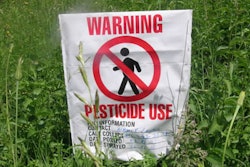To help keep pesticides out of water sources, the Western Integrated Pest Management Center recently created practical, hands-on training modules for professional landscapers and grounds managers, as well as agricultural applicators and home gardeners.
“When the U.S. Geological Survey conducted a 10-year study of pesticides in surface and groundwater, it collected water, sediment and fish samples from hundreds of surface water sites and found pesticide residue in every one of them,” said Western IPM Center Director Jim Farrar. “Most of the concentrations were low and not dangerous to human health, but the findings showed that pesticides often find their way into rivers and streams and they don’t belong there.”
To combat the problem, the Center created the training modules, which are in the form of PowerPoint slide presentations. They can all be downloaded for free on the Western IPM Center website.
Landscaping has its own focus. The landscaping module has a different focus than the ag module, but each delivers similar information.
“Each looks at how pesticides get into water, at soil and pesticide properties that can contribute to pesticides getting into water, and at how to use IPM practices to reduce pesticide contamination,” said Carrie Foss, Washington State University’s urban IPM director and one of the presentations’ authors. “We wanted it to be positive and practical.”
The presentations were peer reviewed before publication, and are designed to be a starting point for trainers—either industry, academic or Extension specialists.
“We expect people to take these modules and adapt them for their local audiences and needs,” Foss said. “We want trainers to add in information they feel is pertinent.”
For instance, the presentations do not contain specific precautions about pyrethroids or organophosphates, and a few reviewers thought they should.
“That type of specific pesticide information is important and it’s something we expect a trainer to include as it relates to their area and audience,” Foss explained.
Gaining acceptance is next step. Foss and others have used the training material for local audiences with good results. The urban modules were shown to a group of local government representatives in Southern California, and others have used various modules with groups as large as 220 people.
Getting the material to landscape contractors’ associations and other industry groups is the next step.
“We need all audiences thinking about what they can do to keep pesticides out of the water,” said University of Nevada’s Susan Donaldson, a co-author and water quality specialist and her state’s pesticide safety education coordinator. “Every little bit helps, and we want people to start doing what they can do.”



















